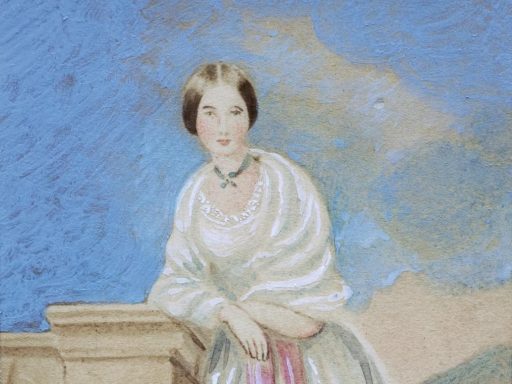The second installment of Miranda Bud’s blogs… The majority of people will need to wear some form of glasses at some point of their lives, and I am no exception. I was fascinated therefore to discover the treasure trove of old spectacles frames and lenses hidden away in the basement of Blythe. The most striking thing about the majority of these spectacles was their size. The glasses have tiny lenses which I can imagine were quite difficult to see through. The […]
It’s November, which means that some of your friends may sprout some dubious facial hair over the next few weeks. Yes, it’s that time of year again when thousands of blokes bid goodbye to their razors and grow a moustache to raise awareness for men’s health issues. For anyone unsure which style to adopt, there’s plenty of inspiration to be found in the Science Museum. The most famous scientific moustache is of course Albert Einstein’s, which has spawned some truly […]
Working in a museum presents all sorts of opportunities you never thought possible. But I imagine few curators have uttered the sentence: “I’m just off to Holland to pick up Napoleon’s toothbrush.” This is exactly my task next week. It’s been on loan to the Boerhaave Museum in Leiden and is normally on display at the Wellcome Collection. Regular readers of this blog will know we like an anniversary and it just so happens that Napoleon died on 5th May 1821, […]
Wrapped up beneath these bandages is a mummified animal. How did it die? What material is it wrapped in? Are there amulets we can’t see inside? Is it an animal at all – could they be human remains? To answer question like these and more, the Science Museum is collaborating in a new nationwide project analysing the remains of ancient Egyptian animals. Led by researchers at the KNH Centre for Biomedical Egyptology, the Ancient Egyptian Animal Biobank project is aiming to scan, sample […]
Here’s the third installment of our festive 4-parter – the 12 days of Christmas re-worked with items from our collections. Check out part 1 and part 2 as well. On the seventh day of Christmas my true love gave to me… 7 Swans a-Swimming Protected by the queen, swans hold a special place in British hearts. In the history of medicine, swan-necked retorts helped one man, Louis Pasteur, develop his germ theory. Pasteur used swan-necked flasks during his experiments on fermentation. The flask […]
It’s that time of year again – time to bellow “five go-oold rings” at the top of your voice. We’ve put together a Christmas cracker of a treat for you with our own alternative version of the Twelve Days of Christmas On the first day of Christmas my true love gave to me… A partridge in a pear tree Well – a sauce container shaped like a partridge at any rate. A rather fetching centrepiece for the festive dinner table […]
The Science Museum’s medical collections are amongst the world’s best. From ancient cultures to the contemporary cutting edge, they continue to be built on the magnificent legacy of the collections assembled by the wealthy entrepreneur Henry Wellcome (1853-1936). Over several decades, Wellcome spent a considerable chunk of his fortune establishing what was once the world’s largest private collection. He bought extravagantly, at auctions or via agents sent out to all corners of the globe. So what’s with the lichen in […]
With the recent release of Burke and Hare, it got me thinking about bodysnatching. Learning anatomy, then and now, meant practicing dissections on cadavers or watching a dissection in an anatomy theatre. Bodies were often in short supply as dissection was taboo for social, cultural and religious reasons. The only bodies that were legally available were executed criminals. Stealing a body was not a criminal offence as technically, the body could not be owned by anyone. If clothes or jewellery were taken, well, that’s […]
Reading Trilce’s recent post, I was reminded of objects from Sir John Franklin’s Arctic expedition within our vast medical collections. Simple items and anonymous fragments, easily overlooked on their storeroom shelves. But they are reminders of one of the most obvious, yet magical things about museum collections – even the most mundane looking objects can be transformed through association. This razor belonged to a member of Franklin’s team. Physically, it’s virtually indistinguishable from others in our collections. But by association, this simple and very […]
As a warm up for Ask a Curator day tomorrow, I thought I would give you an in-depth look at one of our objects that has been generating a lot of comments on Twitter. You may remember a post by my colleague, Stewart, on Arms, legs and ex-Servicemen showing our 20th century collection of prosthetic limbs. The history of artificial limbs is inseparable from the history of amputations and closely linked to warfare. This artificial arm was made for someone who had their left arm amputated above […]

Selina Hurley explores the life and work of Florence Nightingale, the Lady with the Lamp.
Increasing public access to our collections is one of our main priorities. But what do you do when so many of your objects are in storage? Our medical collections are built on the legacy of Victorian entrepreneur Henry Wellcome. He was a millionaire who collected far, wide and en masse. Even our main, highly object-rich medical gallery can only contain a small fraction of the vast number of objects we look after. At our London store, over 40 rooms are devoted […]